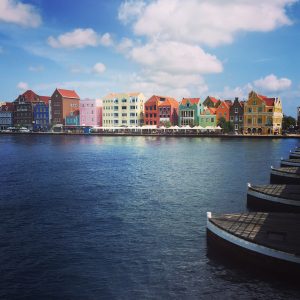
It comes as no surprise that a cruise line like Celebrity Cruises which places such emphasis on the quality and excellence of its culinary offerings would include Culinary Explorations in its shore excursions. These extra-cost forays at its ports of call are selective. When Celebrity stops at a destination not known for its culinary prowess, you’re likely to find the focus shifts to the ports’ strengths. Grand Cayman and Aruba, famous for waters around their islands, saw no food focused tours. Not so with Curaçao and Bonaire. The former, a UNESCO World Heritage site, is the birthplace of Curaçao its namesake liqueur. Bonaire, best known for its scuba diving and snorkeling, is also an island with a long history of salt farming.
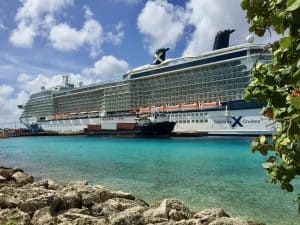
On a ship the size of Celebrity Equinox, the advantage of shore excursions arranged through the ship is two-fold: There’s no worry whatsoever about getting back to the ship on time. You’re guaranteed that they’ll wait for you in the event of any delay. But the other benefits are that you’ll spend a few hours with people who share your special interest whatever it is and on a ship with a long passenger list, it’s a way to meet like-minded people in a small group. And each tour we took, took in not only the Culinary scene but included the most important sights on each island Finally, on the culinary tours we took, no matter how many food fans signed up, we were just 25 people in each air-conditioned tour bus.
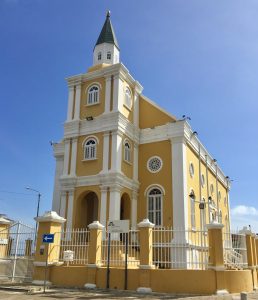
Curaçao’s place on the UNESCO World Heritage Map is obvious the minute you step off the ship. Its capital Willemstad has buildings dating back four centuries and its Dutch past and present is reflected in its architecture. The island was settled by Arawak Indians who arrived here centuries ago from South America which is only 37 miles away. They were joined by the first Europeans to arrive here in 1499 when it was settled by the Spanish. The Spaniards have the ignominious distinction of having rounded up the entire Arawak population which they sold into slavery to nearby Hispaniola– now Haiti and the Dominican Republic. Then came the Dutch who made the island a trading hub. Among its most early settlers where Sephardic Jews who formed the oldest Jewish settlement in the Western Hemisphere when they immigrated from Portugal in the 1500s. Their house of worship, the Mikve Israel-Emanuel Synagogue was consecrated in 1732. One of their number was largely responsible for the production of the liqueur Curaçao.
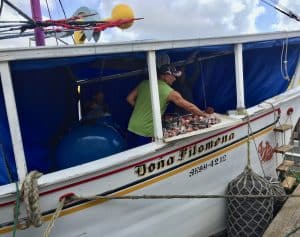 Our taste of Curaçao started with an overview of the island’s history and spectacular views of Willemstad, its picture-perfect capital. Led by an enthusiastic grandmother and guide named Judith Coffie, whose love of her island was infectious, our first stop on the tour was the floating fish and vegetable market. Venezuelan fisherman live aboard their boats and bring the catch of the day right into the center of town. They sell their
Our taste of Curaçao started with an overview of the island’s history and spectacular views of Willemstad, its picture-perfect capital. Led by an enthusiastic grandmother and guide named Judith Coffie, whose love of her island was infectious, our first stop on the tour was the floating fish and vegetable market. Venezuelan fisherman live aboard their boats and bring the catch of the day right into the center of town. They sell their 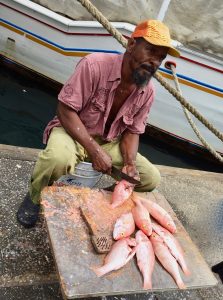 wares from the side of their boats. A little further along the wharf, a second set of Venezuelan boats bring great quantities of fruits and vegetables to the island. Curaçao’s scant rainfall and rocky soil make local cultivation almost impossible. The only reliable fruit on the island is the bitter orange native Laraha, the Golden Orange of Curaçao, from which Curaçao, the liqueur is made which, after a walk through the local market, was where we headed next.
wares from the side of their boats. A little further along the wharf, a second set of Venezuelan boats bring great quantities of fruits and vegetables to the island. Curaçao’s scant rainfall and rocky soil make local cultivation almost impossible. The only reliable fruit on the island is the bitter orange native Laraha, the Golden Orange of Curaçao, from which Curaçao, the liqueur is made which, after a walk through the local market, was where we headed next.

There’s a question of who developed the liqueur itself. Lucas Bols, a distillery in Amsterdam lays claim to its invention by its namesake and founder. The Dutch West Indies Company had taken over Curaçao in 1634 and Bols, who had shares in the company, exported a supply of inexpensive spices for his distillery. Bols discovered that an aromatic oil could be extracted from the unripened peel of the otherwise useless Laraha orange. He used this oil to develop a liqueur similar to what we call “Curaçao today”. He was famous for adding an element of mystery to his products. In this case, blue coloring was added to the liqueur and given the name Crème de Ciel for its blue color.
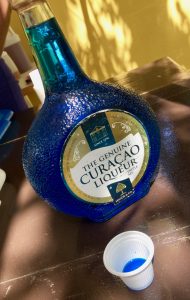
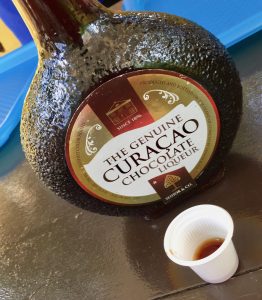
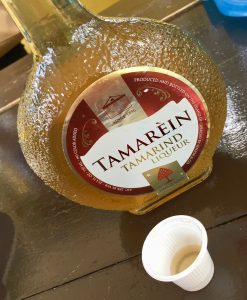
In Curaçao itself, great pride is attached to its local producer, the Senior & Company. Founded in 1896 by a Sephardic Jewish patriarch, the family stated selling their liqueur in small quantities in the family pharmacy. In 1947, the family bought a “Country Manor”, or Landhuis in Dutch, called Chobolobo in Willamstad and since then they’ve continuously it as a distillery. This company is the only one that uses the Laraha fruit grown in Curacao, which allows it to use the word “Genuine” on its labels. It has branched out from the familiar Blue Curaçao and now has a range including Tamarind and Chocolate flavors of the drink, all of which are sampled on the tour.
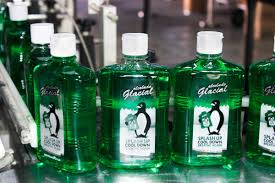 The family pharmaceutical roots are in evidence in one of the other products offered in the company store: Alcolado Glacial. Introduced in 1948 it’s one of those products with multiple claims and uses. It menthol base “refreshes on a hot day”, “relieves headaches and colds” and “repowers” to “energize the muscles, clear the airways”. It was a wildly popular purchase on our tour.
The family pharmaceutical roots are in evidence in one of the other products offered in the company store: Alcolado Glacial. Introduced in 1948 it’s one of those products with multiple claims and uses. It menthol base “refreshes on a hot day”, “relieves headaches and colds” and “repowers” to “energize the muscles, clear the airways”. It was a wildly popular purchase on our tour.
Back on the road again, “ Taste of Curacao” continued its island drive until it arrived at Mambo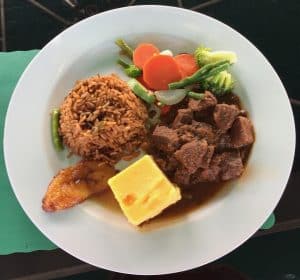 Beach. A set lunch of either Beef or Chicken was included in our tour price. Since Celebrity Equinox’s food is hard to beat, this lunch of a mild beef or chicken curry, polenta cake and beans and rice did not impress but the setting overlooking the swaying palms more than made up for the rather lackluster food.
Beach. A set lunch of either Beef or Chicken was included in our tour price. Since Celebrity Equinox’s food is hard to beat, this lunch of a mild beef or chicken curry, polenta cake and beans and rice did not impress but the setting overlooking the swaying palms more than made up for the rather lackluster food.
After lunch, we headed back to Willemstad, where we could choose to disembark right at the Pontoon Bridge named for Dutch Queen Emma. This bridge is at the entrance to Willemstad harbor, prized for its location sheltered from the sea. The island is a hub of the oil trade. Neighboring Venezuela, a major oil producer, lacks the depth necessary for today’s oil carriers. So Willemstad not only refines Venezuela’s oil, it trans ships it to the rest of the world. The pontoon bridge opens frequently as tankers are guided into the port. If you happen to be on the bridge, a warning signal sounds and pedestrians have to option of scurrying across before the gates close at either end. Or they can stay on the bridge and await its reopening.
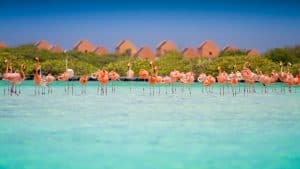
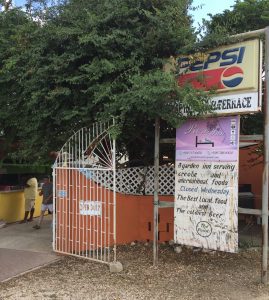
Celebrity Equinox’ next port of call was Bonaire, famous for its dive sites and for its Salt. The steady tradewinds and dry climate have made Bonaire an ideal place to produce salt for three hundred years and counting. The island’s prosperity has been linked to salt and the stunning beds of it in Pekelmeer also harbor a population of pink flamingos, on the hemisphere’s largest. On our way to Pekelmeer, our Bonaire Highlights tour first took us all the way north on the island to a salt water lagoon called Goto Meer where we spied our first flamingos. Unfortunately, the flock was nowhere near shore and any visions we had of a flight of flamingos soon disappeared. Next up, a stop in the town of Rincon, one of six named areas of the island. At the uber Native Rose Café, the island’s Cactus Liqueur was sampled. From there it was on to the Salt Flats. While impressive pyramids of salt awaited transportation to the outside world, the unfortunate history of salt production 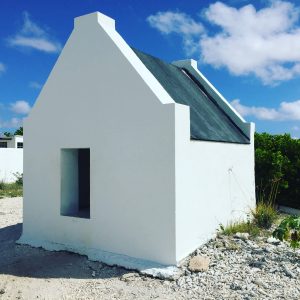 glared at us in the form of “Slave Huts”, tiny white buildings where up to 6 slaves were lodged. These slaves were the backbone of the backbreaking task of salt making.
glared at us in the form of “Slave Huts”, tiny white buildings where up to 6 slaves were lodged. These slaves were the backbone of the backbreaking task of salt making.
Each pyramid, roughly 50-feet high, contains approximately 10,000 metric tons of 99.6{7764cd352edcf19b608e75b52a560f8f0623df8defec59f0ed185161f2ba1413} pure salt. Depending on the time of the year, there can be upwards of 200,000 metric tons of salt neatly stacked in long rows awaiting shipment. The solar salt facility is owned by Cargill, of Minneapolis, Fully 13 percent of the island’s land mass is given over to making salt. Saltwater is drawn from the Caribbean or from the brine lake, the Pekelmeer. The salt moves through a succession of ponds where the salinity increases as the almost constant sun and wind 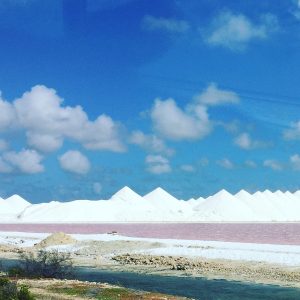 steadily evaporate the salt water. The brine starts out at about 3.5 percent salinity. When it gets to 25 to 30 percent, it is moved into crystalizer ponds. At 37 percent the salt begins to crystallize and forms an 8 to 10 inch layer of pure salt. This takes all of 10 to 12 months depending on the temperature and wind. The harvested salt is washed in sea water until it is 99.6 percent pure. At that point it’s stacked into the unforgettable pyramids. It’s exported all over the world in roughly equal amounts to Europe, Asia and North America.
steadily evaporate the salt water. The brine starts out at about 3.5 percent salinity. When it gets to 25 to 30 percent, it is moved into crystalizer ponds. At 37 percent the salt begins to crystallize and forms an 8 to 10 inch layer of pure salt. This takes all of 10 to 12 months depending on the temperature and wind. The harvested salt is washed in sea water until it is 99.6 percent pure. At that point it’s stacked into the unforgettable pyramids. It’s exported all over the world in roughly equal amounts to Europe, Asia and North America.
Our formal tour went from there back to Bonaire’s capital, Kralendijk. But our food expedition continued on foot, separate from the formal tour. This included a short walk to SaltShop Bonaire where all manner of sea salt in various shapes and sizes were displayed in abundance. The shop also has a 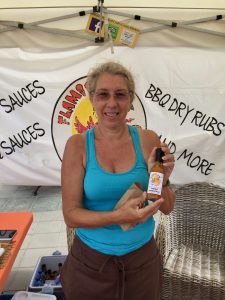 collection of Gourmet Season Salts. But the main draw here were refillable Salt Grinders. On the return to Equinox, a market provided more opportunities to purchase Bonaire foodstuffs including “Flaming Flamingo” Hot Sauces and Spice Blends. Run by expats Wil and Sue, he a Dutchman and she a New Yorker, the variety was striking and only the most hardened gourmet could pass up the chance to sample these made-in-Bonaire specialties. Just before leaving the market, a open air tent featured Indonesian food and we spied more than one crew face enjoying a taste of home. And so our Culinary Adventures in the Caribbean ended. Now on to Equinox final port of call where we’ve signed up for A Taste of Key West. What else?
collection of Gourmet Season Salts. But the main draw here were refillable Salt Grinders. On the return to Equinox, a market provided more opportunities to purchase Bonaire foodstuffs including “Flaming Flamingo” Hot Sauces and Spice Blends. Run by expats Wil and Sue, he a Dutchman and she a New Yorker, the variety was striking and only the most hardened gourmet could pass up the chance to sample these made-in-Bonaire specialties. Just before leaving the market, a open air tent featured Indonesian food and we spied more than one crew face enjoying a taste of home. And so our Culinary Adventures in the Caribbean ended. Now on to Equinox final port of call where we’ve signed up for A Taste of Key West. What else?

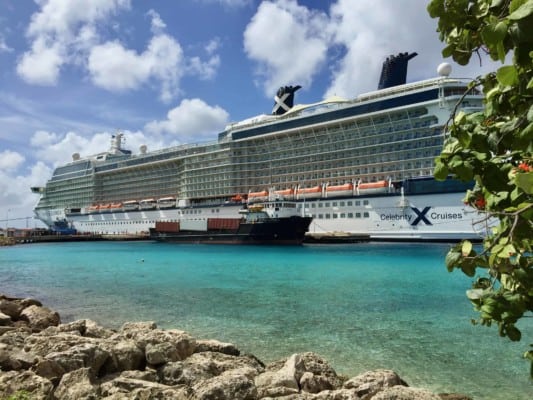
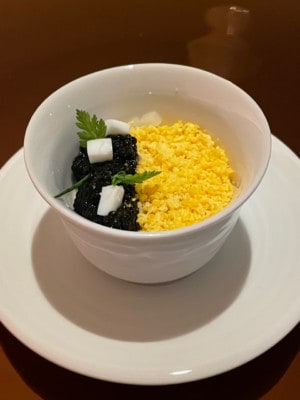











I had decided to snorkel in the morning which left little time to explore more fully Bonaire. Planning on returning as Bonaire was my favorite of the Island stops. It is a low population density island which is appealing and there is a more relaxed atmosphere. In speaking to our Catamaran Captain, who is a transplant from Rotterdam Netherlands, he indicated he and his wife choose Bonaire over Aruba or Curacao because of the small population and spectacular waters just made for snorkeling. I plan on branching out next visit to Bonaire and hoping we can arrive on a day where the majority of the shops and/or eateries are open versus closed as we landed on a Sunday. Overall we had only one meal off the ship in Curacao at what was described as the best burger on Curacao in Rif Fort. But what we saw in Bonaire, including the open air market, was relaxing and the vendors friendly. So sorry we missed the salt hills and Flamingos. Knowing that Solar salt comes from Bonaire will make me remember our voyage next time I refill our water softener.
Marshall, thank you so much for your contribution! I cannot wait until you go back to Bonaire and fill us all in on this wonderful island. All best, Monte